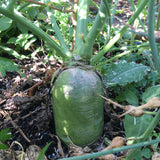Korean Green Luobo Radish
Raphanus sativus
Sweet and spicy long green radish for making kimchi or fresh, crisp, crunchy eating. Lush green foliage with no spines for an itchless harvest. Recommended for fall plantings as it does not do well with summer heat.
This seed was grown for our catalog by Jungeun Kim (J.e.) who hails from Seoul, South Korea. As part of her studies with the Seed Keeping Fellowship at Greensgrow Farms in Philadelphia, she tended to some of her favorite Korean heritage crops from seed to seed. Here’s what she has to say about Korean radishes:
"I think radish is an underestimated root vegetable in the U.S., well at least that's how I feel whenever I go to a grocery store. Radish Kimchi is as popular as cabbage Kimchi in South Korea. You may see sliced radish in cabbage Kimchi. There are so many main and side dishes (such as banchan) that highlight radishes and you can use them in various ways. It's pretty common to use them for different types of broth. You can slice them thin and dry them and make a side dish. You can use the green part of radish in various ways too. Some radishes are sweeter or more bitter than others. If you have garden space, try growing them! If you are a Kimchi lover, try making radish Kimchi."
Last photo by Good Enough Farm.
Days to maturity: 57
Seeds per pack: 125
Germination rate: 87% on 11/4/2025
Planting / harvesting notes
Directly sow radish seeds in loose soil after danger of frost in early spring, and again in late summer for fall crop (the latter is best for this variety). In frost free areas, sow in the fall. Space rows at least 6" apart, and thin seedlings to 2-3" apart within the row. Consider scattering seeds in bands 2-3” wide, 10 seeds per foot. Use row covers to keep out late season pests that munch brassicas.
Seed keeping notes
For seed saving, leave them in for 65-80 days until the pods fully dry and become crunchy/crispy. Harvest the seed head below the lowest ripe seed pods, and hang in a sunny, dry place if it needs to dry a little more. Thresh seed pods by pushing through screens, rubbing between your hands, or stomping in buckets. Sift out larger chaff and use wind, breath, or fans to winnow away the lighter weight chaff from the seed.









